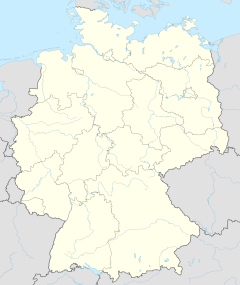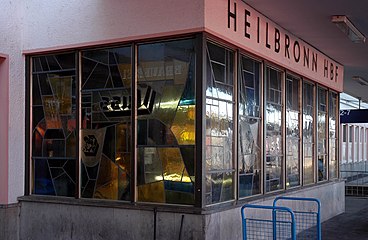railroad.wikisort.org - Station
Heilbronn Hauptbahnhof (German: [haɪlˈbʁɔn ˈhaʊptbaːnˌhoːf] (![]() listen)) is the main passenger railway station in Heilbronn in the German state of Baden-Württemberg.
listen)) is the main passenger railway station in Heilbronn in the German state of Baden-Württemberg.
Heilbronn Hauptbahnhof | ||||||||||||||||||||||||||||||||||||||||||||
|---|---|---|---|---|---|---|---|---|---|---|---|---|---|---|---|---|---|---|---|---|---|---|---|---|---|---|---|---|---|---|---|---|---|---|---|---|---|---|---|---|---|---|---|---|
| Through station | ||||||||||||||||||||||||||||||||||||||||||||
 Reception building, town side | ||||||||||||||||||||||||||||||||||||||||||||
| General information | ||||||||||||||||||||||||||||||||||||||||||||
| Location | Bahnhofstr. 30, Heilbronn, Baden-Württemberg Germany | |||||||||||||||||||||||||||||||||||||||||||
| Coordinates | 49°08′34″N 9°12′29″E | |||||||||||||||||||||||||||||||||||||||||||
| Line(s) |
| |||||||||||||||||||||||||||||||||||||||||||
| Platforms | 7 | |||||||||||||||||||||||||||||||||||||||||||
| Connections | S 4 S 41 S 42 | |||||||||||||||||||||||||||||||||||||||||||
| Other information | ||||||||||||||||||||||||||||||||||||||||||||
| Station code | 2648 | |||||||||||||||||||||||||||||||||||||||||||
| DS100 code | TH[1] | |||||||||||||||||||||||||||||||||||||||||||
| IBNR | 8000157 | |||||||||||||||||||||||||||||||||||||||||||
| Category | 2[2] | |||||||||||||||||||||||||||||||||||||||||||
| Fare zone | HNV: A/10[3] | |||||||||||||||||||||||||||||||||||||||||||
| Website | www.bahnhof.de | |||||||||||||||||||||||||||||||||||||||||||
| History | ||||||||||||||||||||||||||||||||||||||||||||
| Opened | 6 March 1874 | |||||||||||||||||||||||||||||||||||||||||||
| Services | ||||||||||||||||||||||||||||||||||||||||||||
| ||||||||||||||||||||||||||||||||||||||||||||
| Location | ||||||||||||||||||||||||||||||||||||||||||||
 Heilbronn Hauptbahnhof Location in Baden-Württemberg  Heilbronn Hauptbahnhof Location in Germany  Heilbronn Hauptbahnhof Location in Europe | ||||||||||||||||||||||||||||||||||||||||||||
Description
Heilbronn Hauptbahnhof is located about 1 km west of the inner city of Heilbronn and the Old Neckar on a 1 km wide island between the old Neckar and the modern canalised Neckar. Southwest of the modern Neckar is the Heilbronn goods yard. At the western end of the station is the beginning of Bahnhofstraße (station street), which runs over the Friedrich Ebert Bridge and is a direct extension of Kaiserstraße running to Marktplatz (market square), the historic centre of Heilbronn.
Lobby
The main building was completed in 1958 to a design by Hellmut Kasel, based on a preliminary draft by Emil Schuh. The station's front has the canopy roof architecture of the time.[4][5] The station building has a width of 120 m and is built out of concrete and glass, with a copper-covered roof. The central part of the building is a long hall with a glass front, 40 m long, 11.5 m wide and 7.5 m high. The floor of the lobby is made of Jurassic limestone tiles, and the walls are covered with Jurassic and Travertine panels. The ceiling includes a Rabitzkonstruktion (an installation of wire-reinforced plaster, invented by Carl Rabitz), consisting of panels that are sprayed with blue plaster.
The entire lobby is divided by vertical and horizontal lines. The southeast side of the hall consists almost entirely of glass.
To the west of the lobby there was formerly a restaurant, where there is still a stained glass window by Friedrich Knoedler. The west wing has a large open terrace on the ground floor and the former restaurant upstairs. The walls of the restaurant upstairs are covered with elm and maple. There is also a wall mosaic by Friedrich Knoedler. On the staircase there is also a statue of a girl with a fish by Hermann Koziol.
At the eastern end of the station there is a three-storey office building. On the eastern wall of the reception building is a colourful metal relief in silicate paint and wrought iron made in 1958 by Peter Jakob Schober, called "Travel by train—Heilbronn and the world" (Reisen mit der Bahn—Heilbronn und die Welt), which includes symbols of Heilbronn and the world.[6]
The stained glass windows of the subway were created by Valentin Saile.
Forecourt

In the autumn of 1958, a new roof was built above the bus station in front of the station, which was designed by Heinrich Röhm. It was 20 m long and 3.40 m wide and has been described as a "sleek airplane-like structure". It rested on five pillars.[7] The roof was replaced by a suspended honeycomb structure in 1980.
In 2001, a new canopy was built to connect the station with the Heilbronn Stadtbahn stop and the bus station. This was designed by Fritz Auer, Carlo Weber and Götz Guggenberger.
In November 2013, it was decided to name the station forecourt as Willy-Brandt-Platz. It was officially named on 18 December 2013 on the occasion of the 100th birthday of Willy Brandt. The stops for buses and the Stadtbahn outside the station was renamed at the 2013/2014 timetable change in December 2013. It is now officially called Heilbronn Hauptbahnhof/Willy-Brandt-Platz.
Previous station
The original Heilbronn station of 1848 was built a little further east on the Neckar River near the harbour. The tracks to this station ran further south along the modern Bahnhofstraße.
The re-routing of the line and the increase in traffic meant that a new station was built at the current location in 1873. The station building of 1873 was destroyed in an air raid on Heilbronn on 4 December 1944. Today's station was built on its foundations.
- Old station of 1848
- 1873 station
 Plan of the Hauptbahnhof from 1895
Plan of the Hauptbahnhof from 1895- Street map showing station tracks in 1903
Operations
Mühlacker station is classified by Deutsche Bahn as a category 2 station.
Lines
The station is served by the following lines:
- to Mannheim via Eberbach and Heidelberg (Neckar Valley Railway)
- to Heidelberg via Meckenheim (Elsenz Valley Railway)
- Öhringen–Heilbronn–Eppingen–Karlsruhe (Hohenlohe Railway and Kraichgau Railway)
- Öhringen–Heilbronn–Eppingen (–Karlsruhe–Achern) (Heilbronn/Karlsruhe Stadtbahn )
- Stuttgart–Heilbronn–Mosbach-Neckarelz / –Würzburg (Franconia Railway and Neckar Valley Railway )
- to Crailsheim via Öhringen and Schwäbisch Hall (Hohenlohe Railway)
Services
The following lines operate through Heilbronn Hauptbahnhof:
| Service type | Route | Frequency | |
|---|---|---|---|
| Regional-Express | Würzburg – Osterburken – Heilbronn – Stuttgart | 60/120 minutes | |
| Regional-Express | Heilbronn – Öhringen – Schwäbisch Hall – Crailsheim | 120 minutes | |
| Regional-Express | Mannheim – Heidelberg – Meckesheim – Bad Friedrichshall – Heilbronn | 120 minutes | |
| Regional-Express | Mannheim – Heidelberg – Eberbach – Mosbach-Neckarelz – Bad Friedrichshall – Heilbronn | 120 minutes | |
| Regionalbahn | (Osterburken) – Neckarsulm- Heilbronn – Bietigheim-Bissingen – Stuttgart (– Ulm) | 60 minutes every 30 minutes between Heilbronn and Stuttgart | |
| Regionalbahn | Osterburken – Bad Friedrichshall – Heilbronn | 120 minutes | |
| Stadtbahn S 4 (express) | (Weinsberg –) Heilbronn Pfühlpark – Heilbronn Hbf/Willy-Brandt-Platz – Eppingen – Bretten – Karlsruhe – Achern | 60 minutes | |
| Stadtbahn S 4 | (Öhringen-Cappel –) Heilbronn Pfühlpark – Heilbronn Hbf/Willy-Brandt-Platz – Schwaigern West (– Eppingen – Bretten – Karlsruhe) | 20 minutes | |
| Stadtbahn S 41 | Heilbronn Hbf/Willy-Brandt-Platz – Heilbronn Harmonie – Technisches Schulzentrum – Heilbronn Kaufland – Neckarsulm – Bad Friedrichshall – Mosbach-Neckarelz – Mosbach (Baden) | 60 minutes | |
| Stadtbahn S 42 | Heilbronn Hbf/Willy-Brandt-Platz – Heilbronn Harmonie – Technisches Schulzentrum – Heilbronn Kaufland – Neckarsulm – Bad Friedrichshall - Bad Wimpfen – Bad Rappenau – Steinsfurt – Sinsheim (Elsenz) Hbf | 60 minutes | |
Gallery
- Station canopy
- Station hall
- Stained glass window at the entrance to the underpass
Notes
- Eisenbahnatlas Deutschland (German railway atlas) (2009/2010 ed.). Schweers + Wall. 2009. ISBN 978-3-89494-139-0.
- "Stationspreisliste 2022" [Station price list 2022] (PDF) (in German). DB Station&Service. 7 February 2022. Retrieved 13 March 2022.
- "Tarifzonenplan 2021" (PDF). Heilbronner Hohenloher Haller Nahverkehr. 1 January 2021. Retrieved 22 February 2021.
- Fekete, Julius; Haag, Simon; Hanke, Adelheid; Naumann, Daniela (2007). Denkmaltopographie Baden-Württemberg (in German). Vol. I.5 Stadtkreis Heilbronn. Stuttgart: Theiss. pp. 73–74. ISBN 978-3-8062-1988-3.
- Bernhard Lattner with text byJoachim J. Hennze (2005). Stille Zeitzeugen. 500 Jahre Heilbronner Architektur (in German). Heilbronn: Edition Lattner. p. 123. ISBN 3-9807729-6-9.
- Heilbronn und die Kunst der 50er Jahre (in German). Heilbronn: Städtische Museen. 1993. pp. 20, 102 (figure no. 137) and 103.
- Heilbronn und die Kunst der 50er Jahre (in German). Heilbronn: Städtische Museen. 1993. p. 24.
References
- Feitenhansl, Roland (2003). Der Bahnhof Heilbronn – seine Empfangsgebäude von 1848, 1874 und 1958 (in German). Hövelhof: DGEG Medien. ISBN 3-937189-01-7.
External links
- "Heilbronn Hbf track plan" (PDF; 215.2 KB) (in German). Deutsche Bahn. Retrieved 25 January 2011.
- Krauth, Kilian (10 June 2008). "Zug um Zug auf Höhe der Zeit" (in German). Heilbronner Stimme. Retrieved 25 January 2011.
На других языках
[de] Heilbronn Hauptbahnhof
Heilbronn Hauptbahnhof (kurz: Heilbronn Hbf) ist der größte und bedeutendste Personenbahnhof der in Baden-Württemberg liegenden Großstadt Heilbronn. Seit 1848 gibt es eine Schienenverbindung in die Stadt, seit 1874 befindet sich der Hauptbahnhof am heutigen Standort. Das ursprüngliche Empfangsgebäude, welches durch Luftangriffe im Zweiten Weltkrieg zerstört wurde, ist nach dem Krieg durch einen bis heute genutzten Neubau im Stil der Nachkriegsmoderne ersetzt worden. Dieser steht heute als Zeugnis der Architektur der 1950er-Jahre unter Denkmalschutz.- [en] Heilbronn Hauptbahnhof
Другой контент может иметь иную лицензию. Перед использованием материалов сайта WikiSort.org внимательно изучите правила лицензирования конкретных элементов наполнения сайта.
WikiSort.org - проект по пересортировке и дополнению контента Википедии






